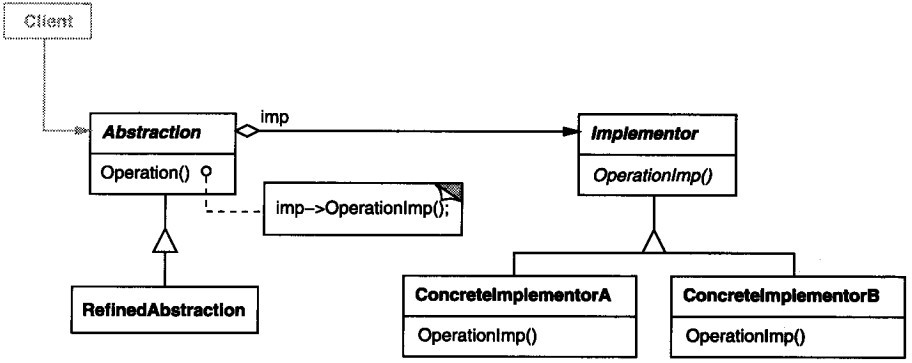桥接模式
解决问题
在有多种可能会变化的情况下,用继承会造成类爆炸问题,扩展起来不灵活。
方案
把这种多角度分类分离出来,让它们独立变化,减少它们之间耦合。
结构

- 抽象类(Abstraction):定义抽象类的接口,维护一个指向Implementor类型对象的指针
- 扩充抽象类(RefinedAbstraction):扩充由Abstraction定义的接口
- 实现类接口(Implementor):定义实现类的接口,该接口不一定要与 Abstraction的接口完全一致;事实上这两个接口可以完全不同。一般来讲, Implementor接口仅提供基本操作,而 Abstraction则定义了基于这些基本操作的较高层次的操作
- 具体实现类(ConcreteImplementor):实现Implementor接口并定义它的具体实现
适用性
- 你不希望在抽象和他的实现部分之间有一个固定的邦定关系,如在程序的运行时刻实现部分应该可以被选择或者切换。
- 类的抽象以及他的视像都可以通过生成子类的方法加以扩充。这时bridge模式使你可以对不同的抽象接口和实现部分进行组合,并对他们进行扩充。
- 对一个抽象的实现部分的修改应该对客户不产生影响,即客户的代码不需要重新编译。
- 你想对客户完全隐藏抽象的实现部分。
- 你想在多个实现间共享实现,但同时要求客户并不知道这一点。
优缺点
优点
- 分离接口及其实现部分: 一个实现未必不变地绑定在一个接口上。抽象类的实现可以在运行时刻进行配置,一个对象甚至可以在运行时刻改变它的实现。
- 提高可扩充性: 你可以独立地对Abstraction和Implementor层次结构进行扩充。
- 实现细节对客户透明
缺点
增加系统的理解与设计难度
经典实现

// 实现类接口
public interface DrawAPI {
public void drawCircle(int radius, int x, int y);
}
// 具体实现类
public class RedCircle implements DrawAPI {
@Override
public void drawCircle(int radius, int x, int y) {
System.out.println("Drawing Circle[ color: red, radius: "
+ radius +", x: " +x+", "+ y +"]");
}
}
// 具体实现类
public class GreenCircle implements DrawAPI {
@Override
public void drawCircle(int radius, int x, int y) {
System.out.println("Drawing Circle[ color: green, radius: "
+ radius +", x: " +x+", "+ y +"]");
}
}
// 抽象类 维护一个指向Implementor类型对象的指针
public abstract class Shape {
protected DrawAPI drawAPI;
protected Shape(DrawAPI drawAPI){
this.drawAPI = drawAPI;
}
public abstract void draw();
}
// 扩充抽象类
public class Circle extends Shape {
private int x, y, radius;
public Circle(int x, int y, int radius, DrawAPI drawAPI) {
super(drawAPI);
this.x = x;
this.y = y;
this.radius = radius;
}
public void draw() {
drawAPI.drawCircle(radius,x,y);
}
}
//
public class BridgePatternDemo {
public static void main(String[] args) {
Shape redCircle = new Circle(100,100, 10, new RedCircle());
Shape greenCircle = new Circle(100,100, 10, new GreenCircle());
redCircle.draw();
greenCircle.draw();
}
}